|
Nov
18
2024
|
|
Posted 1 years 30 days ago ago by Admin
|
|

It is a busy and sunny morning at Joint Base McGuire-Dix-Lakehurst in New Jersey. While the first Boeing KC-135 Stratotanker of the Air National Guard’s 108th Wing takes to the sky, a Boeing C-17 Globemaster and a Boeing KC-46 Pegasus of the 305th Air Mobility Wing, wait in line for their ATC clearance. On the platforms of the United States Marine Corps there is a lot of activity going on as well as a section of Sikorsky CH-53E Super Stallions of HMH-772 being prepared for the day’s flying. Martin Scharenborg and Ramon Wenink / Global Aviation Review Press, were invited to fly with the ‘Hustlers’ and report about the important task this reserve unit has within the United States Marine Corps.
First Steps
The history of the unit goes back to April 1958 when Helicopter Transport Squadron 772 (HMR-772) was established as part of the United States Marine Corps Reserve Training Command at Naval Air Station-Willow Grove in Pennsylvania. The squadron was renamed in April 1962 into Marine Medium Helicopter Squadron 772 (HMM-772) and became part of Marine Aircraft Group 43 / 4th Marine Aircraft Wing in 1965. In 1970, the unit was relocated for a short period to Naval Air Station-Lakehurst where it switched on 1 September 1971 to its current name: Marine Heavy Helicopter Squadron 772 (HMH-772). A year later, the unit returned again to Willow Grove where it became part of Marine Aircraft Group 49 / 2nd Marine Aircraft Wing.
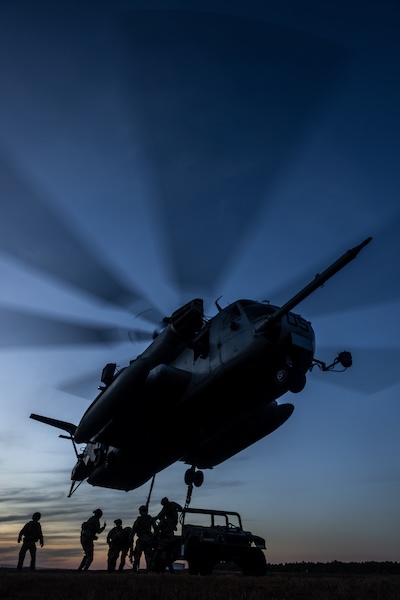
Airmen of the 321st Contingency Response Squadron / 621st Contingency Response Group based at Joint Base McGuire-Dix-Lakehurst, attach a Humvee vehicle to a CH-53E at Lakehurst Maxfield Field during a training with HMH-772 (-). The 321st CRS is specialized in training and rapidly deploying personnel globally to quickly open airfields and establish, expand, sustain, and coordinate air mobility operations during a variety of contingency operations.
The unit operated from 1958 until 1960, the Piasecki UH-25B, which was replaced by the Sikorsky UH-34D Seahorse helicopter. The UH-34D remained in service until December 1971, with it being the last USMC unit to operate this specific aircraft type. The unit received its first CH-53A Sea Stallion helicopters in 1971 and replaced them with the newer RH-53D in 1991. In 1994 the CH-53E Super Stallion was introduced that the unit is still flying today after many life-extending modifications.
Proud history
The unit actively participated in Operation Desert Storm from March until April 1991, Relief Operation Sea Angel after a cyclone hit Bangladesh in May 1991, Operation Fiery Vigil in the Philippines in June 1991, Operation Enduring Freedom and Iraqi Freedom from October 2002 until May 2003. The unit subsequently participated in humanitarian aid and disaster relief operations in the wake of hurricanes Rita and Katrina during September/October 2005. From May until November 2009, HMH-772 deployed back to Afghanistan in support of Operation Enduring Freedom operating from Camp Leatherneck in the Helmand Province.

Marine Heavy Helicopter Squadron 772 “Hustlers” with tail code MT. This unit was the first reserve squadron to receive the special operations capable designator and is the first unit to airlift the Marine Corps’ M777A2 (155 mm lightweight) howitzer in combat.
Keeping Current
On 18 March 2011, HMH-772 moved from Joint Reserve Base Willow Grove to its new and current home at Joint Base McGuire-Dix-Lakehurst (JB MDL) in New Jersey to share the new U.S. Marine Corps buildings and hangars with Marine Aircraft Group 49 and Marine Light Attack Squadron 773 (HMLA-773). Being part of the 4th MAW, the mission for HMH-772 is the same as for any other Marine Force Reserve (MARFORRES) unit: to reinforce and augment the active component of the USMC with ready operational reservists and material. Currently, the USMC has approximately 100,000 reservists and 158 reserve training centers (RTC) in the United States. The training center of HMH-772 is named after Lieutenant Colonel Franklin P. Kolbe, Jr. who died in a crash with a CH-53A of HMH-772 aboard the USS Guam in 1981. The training center is manned by approximately 200 personnel; a mix of active-duty Marines, reservists who drill at least one weekend a month, reservists that train for a longer period in preparation for a specific operation or deployment, and the so-called active reservists who are basically full-time present in the unit.
“The primary mission for our squadron is transportation of heavy equipment, troops and to provide assault support for the Marine Air Ground Task Force (MAGTF) The other role for us as a reserve unit is that we are there to support any kind of gap or anything that the active units may need a little help with, like transitioning to a new aircraft while they are busy with a turnover…..Every five years or so, a reserve unit is able to be used for deployments, UDPs (Unit Deployment Programs), or maybe help out with SOUTHCOM when they are in need of heavy-lift support. We kind of fill in those gaps. For example, this Squadron was activated to go help out in Haiti in 2016 after the earthquake they had. Whenever those types of crises pop up and any other units are otherwise employed or forward deployed, the USMC will use our squadron for those missions as well,” explains Captain Peter Shawhan, instructor pilot with HMH-772. He started his flying career at a flight school with approximately 10 hours flown on a single-engine Piper aircraft followed by the Naval flight school on the Raytheon T-6 Texan II. After that, he was sent to helicopter introductory training on the Bell TH-57 Sea Ranger for approximately 70 hours before going to USMC’s CH-53 training unit HMHT 302 of the 2nd MAW / MAG-29 at MCAS New River in 2016. This was followed by a four-year assignment with HMH-366 also at MCAS New River. In 2020, he became an instructor pilot with HMH-772 at Joint Base McGuire-Dix-Lakehurst having accumulated 1,300 flying hours of which 1,000 hours are in the CH-53E. “I am one of the active guys that keeps the reservists current on their flight hours,” he said.
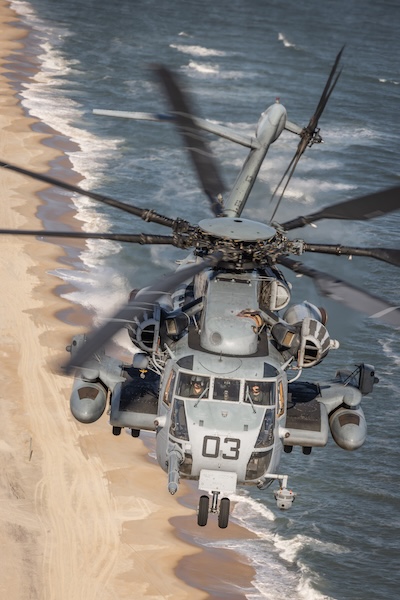
Proven reliability
Having first entered service with the Marine Corps in 1981 and having reached the million flying hours milestone in July 2019, the CH-53E Super Stallion is still the backbone of the USMC’s helicopter transport fleet with currently around 140 aircraft in service. Over the years, airframe and avionics have been drastically refined. The CH-53E can take up to 32 passengers, and this can be expanded to 55 when the centerline seats are fitted. In the medical-evacuation configuration (MEDEVAC) the aircraft can take 24 litters and two seats or six litters with 20 seats. In the transport configuration, the cargo bay can fit six 48”x 48” pallets, or two, two-seat MRZR’s (a light utility task vehicle) or one four-seat MRZR. Externally, the CH-53E can lift 36,000 pounds either on the dual-point hook or on a single hook.
For self-protection and to protect forces on the ground, the CH-53E can be fitted with three .50 GAU-21 rapid-fire machine guns. One on each side and one on the loading ramp. Furthermore, the airframe can be fitted with the Ballistic Protection System. These are armored plates that contain a mix of Kevlar and steel to protect the helicopter against bullets and blast fragments. To identify threats, the crew has the AN/APR-39(V)1 Radar Warning Receiver (RWR), the AN/AAR-47V2 Missile and Laser Warning System, the AN/AAQ-24 Directional Infrared Countermeasure and the AN/ALE-47 Airborne Countermeasure Dispenser System (CMDS) at its disposal. To improve the workload of the aircrew and to enhance the interoperability with units on the ground and in the air, the avionics suite was drastically modernized to include GPS-navigation, Head-Up Displays (HUD), ANVIS-9 night vision goggles, three AN/ARC-210(V) Radio Communications Systems, DAMA (Demand Assigned Multiple Access) SATCOM and the AN/AAQ-29A Forward looking Infrared (FLIR) Imaging system.
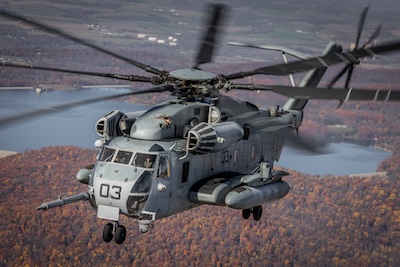
“The CH-53E is a great helicopter and it does what it is designed for. It helps that it has three engines as well. It provides a lot of power and a lot of torque. It is a very big helicopter and the frame can handle a lot of loads. Furthermore, I think that the survivability is excellent due to the wide range of self-protection systems it has. We also have a HUD-attachment that will go on the goggles. We can put certain flight data into the system that gives us some hovering data and drift information, rate of climb, rate of descent, and our heading. We can also declutter it by turning off those individual systems on our HUDs.” adds Capt. Shawhan.
Helicopter Air-to-Air Refueling (HAAR)
“One of the unique features of the CH-53E is that it is capable of air-to-air refueling. Without refueling, the endurance of the CH-53E, depending on weight, cargo and mission, is approximately 3.5 hours. In situations where you have to range a big distance… sometimes HAAR is absolutely vital to that kind of mission. It is also very important for us to remain on station longer. Let’s say we conduct an insert with the Marines and they expect an extract at a certain time; they want us to be available for any sort of contingency, such as a CASEVAC (casualty evacuation) or if there is something else they want us to come in for. When we fly back to base or land on deck, we will not be available for them. If we go up to the AAR-track and refuel, and if they need us at a moment’s notice, we can get off the hose and come in immediately and respond. It increases our flexibility and response time drastically,” says Shawhan.
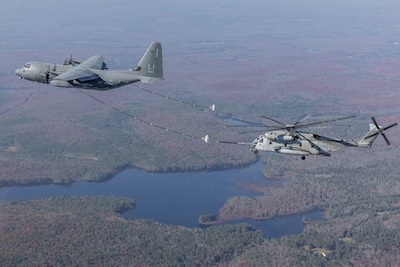
HMH-772 has officially been a ‘Squadron Minus’ (-) since 2008 and is operating only six CH-53E aircraft. With fielding of the first CH-53K’s during 2022 in the 2nd Marine Aircraft Wing, it is expected that soon more CH-53E’s will become available for HMH-772 so the unit can build up again to a ‘1.0 Squadron’ with eventually 16 aircraft.
“Training this specific skill is one of the things that is harder to schedule: you have to have good weather, the aircraft have to cooperate maintenance wise, and you have to have the external support of the C-130 Hercules unit. As a result we don’t do it as routinely as we would like to do, so every time you are knocking off a little bit of rust. There is a very small margin for error, and as a result your stress level is a little bit higher. Helicopter air-to-air refueling is heavy finesse,” adds Major Jason W. Stapleton, operations officer at HMH-772. He was commissioned in May 2007 and earned his wings in 2009. He started training on the TH-57 in Pensacola and completed flight training on the CH-53E in April 2010 with HMHT 302 at MCAS New River and became assigned to HMH-366, also based at MCAS New River. Stapleton was subsequently deployed to Afghanistan in the Helmand Province. From November 2011 until the summer of 2012, he was deployed back again to Afghanistan. He participated actively in relief efforts during Hurricane Sandy from October till November 2012 with the 26th Marine Expeditionary Unit deployed aboard the USS Wasp (LHD-1). In April 2016 he went to HMX-1 at MCAS Quantico to fly the Presidential helicopters and moved in July 2021 to HMH-772 at Joint Base McGuire-Dix-Lakehurst to become Operations Officer in charge of flight planning and exercises. To date, he’s accumulated 2,500 flight hours with 500 during combat.
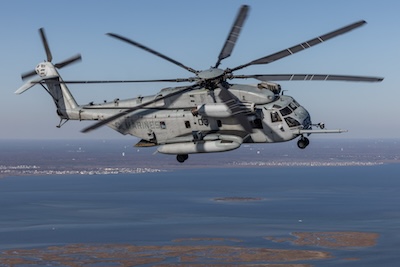
The CH-53E Super Stallions of the United States Marine Corps will go through the RESET program, initiated by the Naval Air Systems Command (NAVAIR) in 2016. To reduce maintenance hours, fuel leakages and to prolong the life span, the aircraft will receive new high time components and a fresh paint. The first aircraft returned from the RESET program in 2019 while in October 2022 the 50th aircraft was returned to its unit.
RESET Program
In February 2019, the first CH-53E Super Stallion was delivered back to its USMC unit after an extensive and quite specific overhaul of the entire airframe. This special program named ‘RESET’ was initiated by the Naval Air Systems Command (NAVAIR) and was started in 2016 to replace high-time parts on the CH-53E to extend the lifespan of the helicopters, reduce maintenance hours and to deliver a leak-free and more cost-efficient full-mission-capable (FMC) aircraft. “They completely refit everything and put a new fresh coat of paint on it. They look into any tiny little leak and make sure that everything is spotless and perfect, as close as factory new. They completely ‘reset’ the aircraft to get some more life out of it, which requires approximately two years to get that kind of maintenance done. Eventually RESET will result in a higher readiness level of our CH-53E fleet!”, explains Shawhan. By October 2022, already 50 of the originally intended 142 CH-53E’s had undergone the RESET program.
Minus (-)
During 2008, Marine Heavy Helicopter Squadron 772 was reorganized and reduced to the size of a ‘Squadron Minus’ and henceforth officially designated as HMH-772 (-). “We are typically a ‘Minus’ as we only have six aircraft at the moment. We are a reduced squadron but we are eventually going to be plussed right up to 12 aircraft. Since we are a reserve unit, most of the helicopters go to the active-duty squadrons right now, but in due time when the CH-53K will come online, they will not need the older helicopters anymore and we can start building up to a 1.0 squadron with approximately 16 aircraft. We hope to have eight helicopters by March 2023. HMH-772 (-) Minus was kind of a temporary thing”, clarifies Stapleton.
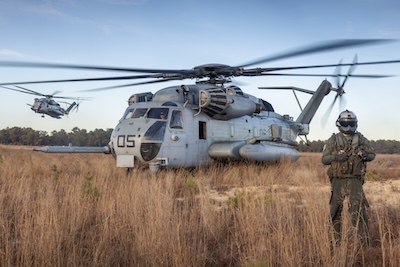
The standard crew of a CH-53E consists of one pilot, one co-pilot and two crew chiefs, one on each window, and sometimes added by a tail gunner. “When we are a little bit light on crew members, we are allowed to fly with one crew chief for example for ferry flights, but for terrain flights you definitely require two crew chiefs”, explains Instructor Pilot Captain Peter Shawhan.
“Although we are a small unit at the moment, we still can be activated like recently in March (2022) for Exercise Caribbean Urban Warrior. This is an annual exercise between our Second Reconnaissance Battalion and the Dutch 32nd Raiding Squadron that took place at MCAS New River and at Camp Le Jeune, where we provided heavy-lift support for the infantry units. We also participated in March in the live-firing Exercise Rolling Thunder and Exercise Gunslinger in Kansas in June,” adds Stapleton.
FORCE DESIGN 2030
The United States Marine Corps is aiming in its Force Design 2030 to have equipped two reserve and eight active squadrons with the new CH-53K King Stallion by 2030. Active HMH-461 at MCAS New River will become the first operational unit to operate the type, followed by the other CH-53 units of the 2nd, 1st, 3rd and 4th Marine Aircraft Wing. “As HMH-772 (-) is a reserve unit, I expect that transition to the CH-53K will start no sooner than 2029 or 2030. Till then, we will continue to operate the venerable CH-53E and keep reserve aircrew current on the type,” concludes Stapleton.
READ MORE ROTOR PRO: https://justhelicopters.com/Magazine
WATCH ROTOR PRO YOUTUBE CHANNEL: https://buff.ly/3Md0T3y
You can also find us on
Instagram - https://www.instagram.com/rotorpro1
Facebook - https://www.facebook.com/rotorpro1
Twitter - https://twitter.com/justhelicopters
LinkedIn - https://www.linkedin.com/company/rotorpro1